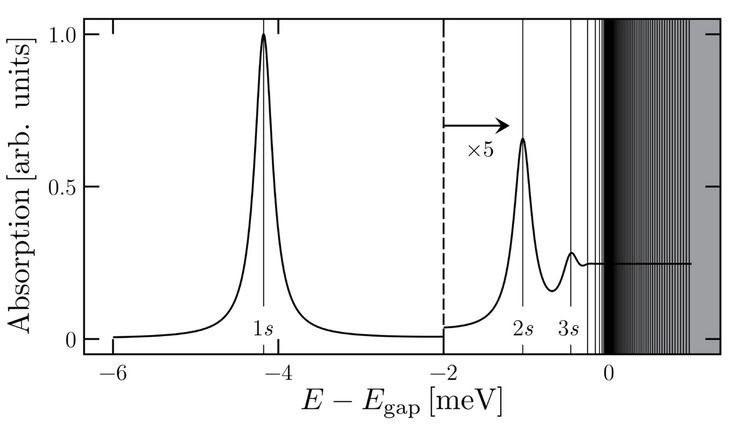 | ||
The Elliott formula describes analytically, or with few adjustable parameters such as the dephasing constant, the light absorption or emission spectra of solids. It was originally derived by Roger James Elliott to describe linear absorption based on properties of a single electron–hole pair. The analysis can be extended to a many-body investigation with full predictive powers when all parameters are computed microscopically using, e.g., the semiconductor Bloch equations (abbreviated as SBEs) or the semiconductor luminescence equations (abbreviated as SLEs).
Contents
Background
One of the most accurate theories of semiconductor absorption and photoluminescence is provided by the SBEs and SLEs, respectively. Both of them are systematically derived starting from the many-body/quantum-optical system Hamiltonian and fully describe the resulting quantum dynamics of optical and quantum-optical observables such as optical polarization (SBEs) and photoluminescence intensity (SLEs). All relevant many-body effects can be systematically included by using various techniques such as the cluster-expansion approach.
Both the SBEs and SLEs contain an identical homogeneous part driven either by a classical field (SBEs) or by a spontaneous-emission source (SLEs). This homogeneous part yields an eigenvalue problem that can be expressed through the generalized Wannier equation that can be solved analytically in special cases. In particular, the low-density Wannier equation is analogous to bound solutions of the hydrogen problem of quantum mechanics. These are often referred to as exciton solutions and they formally describe Coulombic binding by oppositely charged electrons and holes. The actual physical meaning of excitonic states is discussed further in connection with the SBEs and SLEs. The exciton eigenfunctions are denoted by
These exciton eigenstates provide valuable insight to SBEs and SLEs, especially, when one analyses the linear semiconductor absorption spectrum or photoluminescence at steady-state conditions. One simply uses the constructed eigenstates to diagonalize the homogeneous parts of the SBEs and SLEs. Under the steady-state conditions, the resulting equations can be solved analytically when one further approximates dephasing due to higher-order many-body effects. When such effects are fully included, one must resort to a numeric approach. After the exciton states are obtained, one can eventually express the linear absorption and steady-state photoluminescence analytically.
The same approach can be applied to compute absorption spectrum for fields that are in the terahertz (abbreviated as THz) range of electromagnetic radiation. Since the THz-photon energy lies within the meV range, it is mostly resonant with the many-body states, not the interband transitions that are typically in the eV range. Technically, the THz investigations are an extension of the ordinary SBEs and/or involve solving the dynamics of two-particle correlations explicitly. Like for the optical absorption and emission problem, one can diagonalize the homogeneous parts that emerge analytically with the help of the exciton eigenstates. Once the diagonalization is completed, one can then compute the THz absorption analytically.
All of these derivations rely on the steady-state conditions and the analytic knowledge of the exciton states. Furthermore, the effect of further many-body contributions, such as the excitation-induced dephasing, can be included microscopically to the Wannier solver, which removes the need to introduce phenomenological dephasing constant, energy shifts, or screening of the Coulomb interaction.
Linear optical absorption
Linear absorption of broadband weak optical probe can then be expressed as
where
Each of the exciton resonances can produce a peak to the absorption spectrum when the photon energy matches with
In general, the exciton eigen energies consist of a series of bound states that emerge energetically well below the fundamental bandgap energy and a continuum of unbound states that appear for energies above the bandgap. Therefore, a typical semiconductor's low-density absorption spectrum shows a series of exciton resonances and then a continuum-absorption tail. For realistic situations,
The concentration of charge carriers influence the shape of the absorption spectrum considerably. For high enough densities, all
Even though one can understand the principal behavior of semiconductor absorption on the basis of the Elliott formula, detailed predictions of the exact
Photoluminescence Elliott formula
After the semiconductor becomes electronically excited, the carrier system relaxes into a quasiequilibrium. At the same time, vacuum-field fluctuations trigger spontaneous recombination of electrons and holes (electronic vacancies) via spontaneous emission of photons. At quasiequilibrium, this yields a steady-state photon flux emitted by the semiconductor. By starting from the SLEs, the steady-state photoluminescence (abbreviated as PL) can be cast into the form
that is very similar to the Elliott formula for the optical absorption. As a major difference, the numerator has a new contribution – the spontaneous-emission source
that contains electron and hole distributions
The
Like for the absorption, a direct-gap semiconductor emits light only at the resonances corresponding to the
Terahertz Elliott formula
As discussed above, it is often meaningful to tune the electromagnetic field to be resonant with the transitions between two many-body states. For example, one can follow how a bound exciton is excited from its 1s ground state to a 2p state. In several semiconductor systems, one needs THz fields to induce such transitions. By starting from a steady-state configuration of electron–hole correlations, the diagonalization of THz-induced dynamics yields a THz absorption spectrum
In this notation, the diagonal contributions
In contrast to optical absorption and photoluminescence, THz absorption may involve all exciton states. This can be seen from the spectral response function
that contains the current-matrix elements
In contrast to optical and photoluminescence spectroscopy, THz absorption can directly measure the presence of exciton populations in full analogy to atomic spectroscopy. For example, the presence of a pronounced 1s-to-2p resonance in THz absorption uniquely identifies the presence of excitons as detected experimentally in Ref. As a major difference to atomic spectroscopy, semiconductor resonances contain a strong excitation-induced dephasing that produces much broader resonances than in atomic spectroscopy. In fact, one typically can resolve only one 1s-to-2p resonance because the dephasing constant
